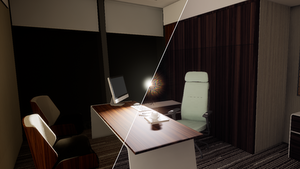Information
- Publication Type: Master Thesis
- Workgroup(s)/Project(s):
- Date: February 2020
- Date (Start): April 2019
- Date (End): 2. February 2020
- Diploma Examination: 10. February 2020
- First Supervisor:
- Keywords: perception, temporal eye adaptation, glare, virtual reality, scotopic vision, visual acuity reduction, augmented reality
Abstract
The perception of light and light incidence in the human eye is substantially different in real-world scenarios and virtual reality (VR) simulations. Standard low dynamic range displays, as used in common VR headsets, are not able to replicate the same light intensities we see in reality. Therefore, light phenomenons, such as temporal eye adaptation, perceptual glare, visual acuity reduction and scotopic color vision need to be simulated to generate realistic images. Even though, a physically based simulation of these effects could increase the perceived reality of VR applications, this topic has not been thoroughly researched yet.
We propose a post-processing workflow for VR and augmented reality (AR), using eye tracking, that is based on medical studies of the healthy human eye and is able to run in real time, to simulate light effects as close to reality as possible. We improve an existing temporal eye adaptation algorithm to be view-dependent. We adapt a medically based glare simulation to run in VR and AR. Additionally, we add eye tracking to adjust the glare intensity according to the viewing direction and the glare appearance depending on the user’s pupil size. We propose a new function fit for the reduction of visual acuity in VR head mounted displays. Finally, we include scotopic color vision for more realistic rendering of low-light scenes.
We conducted a primarily qualitative pilot study, comparing a real-world low-light scene to our VR simulation through individual, perceptual evaluation. Most participants mentioned, that the simulation of temporal eye adaptation, visual acuity reduction and scotopic color vision was similar or the same as their own perception in the real world. However, further work is necessary to improve the appearance and movement of our proposed glare kernel. We conclude, that our work has laid a ground base for further research regarding the simulation and individual adaptation to the perception of light in VR.
Additional Files and Images
Additional images and videos
Additional files
Weblinks
BibTeX
@mastersthesis{Luidolt-2020-DA,
title = "Perception of Light in Virtual Reality",
author = "Laura R. Luidolt",
year = "2020",
abstract = "The perception of light and light incidence in the human eye
is substantially different in real-world scenarios and
virtual reality (VR) simulations. Standard low dynamic range
displays, as used in common VR headsets, are not able to
replicate the same light intensities we see in reality.
Therefore, light phenomenons, such as temporal eye
adaptation, perceptual glare, visual acuity reduction and
scotopic color vision need to be simulated to generate
realistic images. Even though, a physically based simulation
of these effects could increase the perceived reality of VR
applications, this topic has not been thoroughly researched
yet. We propose a post-processing workflow for VR and
augmented reality (AR), using eye tracking, that is based on
medical studies of the healthy human eye and is able to run
in real time, to simulate light effects as close to reality
as possible. We improve an existing temporal eye adaptation
algorithm to be view-dependent. We adapt a medically based
glare simulation to run in VR and AR. Additionally, we add
eye tracking to adjust the glare intensity according to the
viewing direction and the glare appearance depending on the
user’s pupil size. We propose a new function fit for the
reduction of visual acuity in VR head mounted displays.
Finally, we include scotopic color vision for more realistic
rendering of low-light scenes. We conducted a primarily
qualitative pilot study, comparing a real-world low-light
scene to our VR simulation through individual, perceptual
evaluation. Most participants mentioned, that the simulation
of temporal eye adaptation, visual acuity reduction and
scotopic color vision was similar or the same as their own
perception in the real world. However, further work is
necessary to improve the appearance and movement of our
proposed glare kernel. We conclude, that our work has laid a
ground base for further research regarding the simulation
and individual adaptation to the perception of light in VR.",
month = feb,
address = "Favoritenstrasse 9-11/E193-02, A-1040 Vienna, Austria",
school = "Research Unit of Computer Graphics, Institute of Visual
Computing and Human-Centered Technology, Faculty of
Informatics, TU Wien",
keywords = "perception, temporal eye adaptation, glare, virtual reality,
scotopic vision, visual acuity reduction, augmented reality",
URL = "https://www.cg.tuwien.ac.at/research/publications/2020/Luidolt-2020-DA/",
}


 poster
poster thesis
thesis

